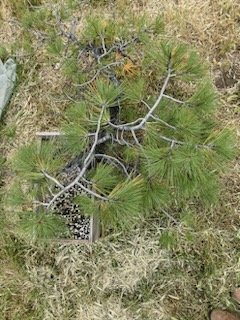Yamadori Ponderosa initial design
Hey Interweb folks,
In this post, I’ll share some mid-winter work on a collected Pondo.
This is an ideal time to get things kicked off with this species. Let me run back the tape for you on the story of how we got here…..
This tree was collected up at about 7000 Vft in the fall of 2020 by a friend of mine AJ & me. Being one of the first collected trees by my buddy, I assisted with getting the tree off to a good start & hoping to help him avoid any unneeded scar tissue on his yamadori journey.
Yamadori pondo on AJ’s pack.
After collection, the tree was boxed up. It was positioned in a tight box with good drainage and at an angle to optimize foliage production. This tree didn’t skip a beat and recovered well. AJ kept the tree at his place and informed me of the status regularly. We examined the progression of the tree from 2020 into 2023, bringing it over for events and health checks.
In Jan we needed to look at the tree’s root system and compare it to the foliage load. Given the newly formed buds and the condition of the tree, I was confident we would see an excellent root structure. The first step was to remove the tree from the box and lay out the roots. Going through this process allows us to remove any dead roots from the mass, examine where heavy roots are, and make needed reductions. It also allows us a chance to reposition the tree for design. Keep in mind as the tree comes off the mountain and begins its recovery process, the tree will tell you what needs to happen for its optimal position and if you’re lucky it will tell you how it wants to be styled.
After we brought the tree into the workshop and placed it in position for the work, we removed the anchor wires along with a few of the side panels of the box. The tree had filled the box with new roots. This is a real testament to AJ’s post-collecting care (nice job buddy!).
Next, we started working through the root mass and made some minor cuts to heavy rootage and the small sections of dead roots. This is a point I see as a common struggle for many bonsai practitioners…. Do I place the tree in a new container (ceramic or training pot) or do I reuse the current recovery box? This is a challenge for many of us because we often times want to rush the trees into ceramic containers. We tell ourselves, the tree will look better, it will be one step closer to being “finished” etc., etc. Well, we chose to reuse the current box and simply cut it down making it easier to handle and we already knew the tree would respond well to another year or two in this container (if needed). The recovery box isn’t glamorous and it’s oversized for the final image of the tree. But the big picture here is, this tree is likely 300ish years old…. SO…. why rush this into a container and risk its health? Spend another year or two developing and examining the growth. Look for containers that will fit the style and enjoy the journey. Ok, stepping off my soap box….
Our next step in the process is to determine does the tree need another year or two to recover (without work or pruning). Or was it ready to move forward with some structural styling? Keep in mind, the strength in pines comes from the roots, so this tree was ready for an initial styling.
↓ Before repotting and angle change ↓ ↓ After repotting and angle change ↓
After changing the planting angle and examining the flow of the tree from base to branch tips, we placed the tree back in the grow box, changed the planting angle slightly, and determined the left side of the tree needed to be elevated. Then, we placed some guy wires on the tree to pull branches down and determine if the vision was acceptable or in need of change. Sometimes, the best method is to approach trees like this slowly (particularly if the practitioner is new or new-ish to bonsai which AJ is). This is not to take anything away from AJ and his abilities, however oftentimes (AND I KNOW many of you reading this are just as guilty as I am… and) we rush into work too quickly sometimes. So approaching work like this in phases or spacing out the work to cleanse the visual palette can help. (I know it does for me). OK - so we decided to go slower and look at the tree placing branches in proximity to their location with guy wires and then review it over a few weeks.
↓ AJ working on his Pondo ↓
Coming back to the tree after a few weeks passed, we continued to review the tree and “clear the visual clutter”. We cleaned up unneeded branches, twigs, and some deadwood. We worked on structural wiring the branches and removed guy wires as appropriate. With a few hours of heavy wiring and some legit bending, we had a solid structure set. we looked at the flow and movement of the tree. We thought through some Bonsai Mirai strategies like enhancing the asymmetry and showing more remnants of what was with the jinning of the left top branch. There were lots of options here. Going back to what I said earlier, we are taking our time with this material and showing it the respect it deserves. But for now, we are very happy with the initial setup. I’ll keep you posted on the development of this tree.
Thanks for sticking around!
Jon












